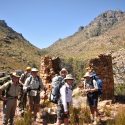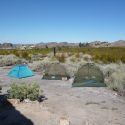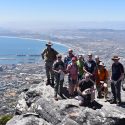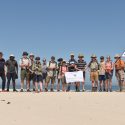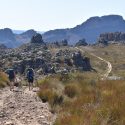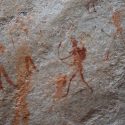EXERCISE COCKNEY STRANDLOPER – SOUTH AFRICA – FEBRUARY – MARCH 2020 – A report by Maj L.E.S. Webb RE
“I wish I was still there” (Quote by Major Lizzie Stileman who is now ( as at 01 Apr 20) fully committed to operations in support of COVID19)
This report will share the story of Exercise Cockney Strandloper to South Africa, which took place from 16 February to 10 March, 2020. The goal of the expedition was to build skills in leadership, self-confidence and endurance, alongside team cohesion in the arid, desert environment, and to explore the region of Cederburg and trek alongside the South Atlantic Ocean. Along the way, we also learned how to entertain and deter troops of baboons, a spot of local history, and – as explained wisely to us by a seasoned desert guide and ex- South Africa Army Officer “you can only walk to the limits of your water, and you can’t drink sand!” . Read on…
We arrived in Cape Town, South Africa in February, feeling eager and spontaneous after a last-minute destination change from Namibia. “It’s a bit warm here, but it’s even hotter in Cederberg” turned out to be the understatement of the day from our support team commander, WO2 Stevie Renwick, unknowingly foreshadowing the results of all our activities for the next ten days. The group was made up of fifteen officers and soldiers, mainly reservists, from the National Reserve Headquarters and HQ Woolwich Station, supported by an able medical team of three from 207 and 243 Field Hospitals Royal Army Medical Corps. The Subject Matter Expert (SME) and one of the designated mountain leaders for the exercise was a native South African, Afrikaans speaker from the British Army Training Unit Kenya (BATUK). He joined the team fresh from Nanyuki.
Our base camp for the exercise was the Kliphuis Campsite in Cederberg, located in the mountainous desert region of the Western Cape in South Africa. It was a sandy spot in the valley, located beside a semi-arid waterhole, wedged between some particularly tall (and presumably eponymous) Cedar trees and a series of overgrown, rocky terraces. The camp was framed by the beautifully clear, blue horizon, and a soaring ridgeline on the other side of the valley. An attractive home-from-home for us, and a permanent residence for a den of yellow snakes, which the local police commander Lt Col. Nel reassuringly advised us to watch out for. Something about them being deadly, apparently.
Early in the trip we had been informed by a South African official that the area was at the apex of a harsh three-year drought, which showed as our approach journey northbound from Cape Town to Cederberg became hotter and dryer with every step. Memories of grazing cattle gave way to cornfields, then orange groves and Rooibos tea plantations losing presence beneath the oven-like sky filled with that constant, relentless sun. Nevertheless, the levels of anticipation, morale and excitement remained high in the group, who got to work building ‘bug domes’ and poncho-bashas to sleep beneath. The provided tents we had brought just wouldn’t have been comfortable to sleep under in the heat, and with the magical adventure of camping under the magnificent canopy of stars each night our own austere cover-ups became the preferred bedding option throughout the whole exercise.
While we were happy and comfortable to be in our basecamp, a fellow troop which joined us seemed less pleased at our presence. Twenty boisterous baboons, scattered about on the rocky outcrop skyline surrounding our spot just weren’t too impressed to have us there, perhaps due to our proximity to ‘their’ watering hole. A medic joked “they look just like us – perhaps a bit better looking”, but the monkeys weren’t having the compliment and we realised something would have to be done to ensure they knew to stay away. We are amused to report that we soon discovered that the act of jumping up and down and making ape noises would encourage the baboons to do the same, before starting to throw stones and dirt at one another (the monkeys that is, not the troops). This provided endless amusement for the soldiers, hard at work, until all of a sudden, the baboons got tired of us and left.
The forewarned weather conditions proved to be limiting factors in the journey, and needed to be carefully managed. Although we had water purification equipment to hand, shared concerns over the lack of naturally occurring water in the mountains drew us into consideration of alternative plans, in order to ensure that we were able to manage the risks whilst staying within our authorised remit. The growing heat was also a limiting factor, and our Mountain Leaders planned short dusk and dawn acclimatisation treks and achievable daily objectives to help combat the problem thus limiting our exploitation into the interior. With these changes in mind, our training finished and we began trekking on the 26th February with a circumnavigation of the Kliphius Ridge. In all, this was about nine miles of ups and downs along the rocky escarpments which dominated the ridgeline to the North of our campsite. The waterfall and rock pools we were expecting had clearly also succumbed to the drought problem, as instead of the blue waters we had had hoped to see there was just a bit of fly-blown swamp ground and a trickle amongst the rocks instead. At the end of a hard day’s trekking we returned to camp, only to find the baboons were back to their act of banging around on rocks for a few hours. Almost as if to give us a subtle warning to leave them and their mud-hole alone. We didn’t falter, and eventually they left!
Amongst our daily walks, a three-day and two-night expedition had been planned. This was made possible by the discovery of a reliable water source in an old Dutch-style village named Hueningvlei, located on the other side of the ridgeline, to the South East. This route also made possible a secondary aspiration to summit a peak named Groot Krakadeuw and a chance to cross the Krakadeuw pass. All in, this created an exciting circular trek, back to almost the same place we started from. Perfect. Unfortunately the extreme heat led to a dynamic revision of the plan – healthy discussion about the logistics of attempting the mountain, although not far away, but with our drinking water limited to what could be carried it would require a logistic carry to position a reserve supply in order to ensure a safe withdrawal – after a very hot night under the stars on the mountainside it was decided to ‘scrub’ the mountain and concentrate on an extraction march over the Krakadeuw Pass to the evening RV with the transport. Even in its simplicity this turned out to be a very difficult march, heat and thorn bushes taking their toll.
As any explorer can tell you, it would be very rare and exciting to execute a full expedition exactly as planned, as external elements will often call for a detour. Sadly, the effects of the drought and wind had that impact on us. Our grand plans to exploit South across Cederberg on a series of mini-expeditions did not work out as planned, and we swapped wildcamping beside waterfalls and mountain streams for daily mountain objectives and treks instead. From this, we were able to trek to discover more fascinating local heritage, including ancient cave paintings and artifacts residual from the South African Boer wars of 1899-1902.
Whilst still in the planning stages of the trip we had established that no Joint Service British Military group had ventured into Cederberg during recent times , which rendered our visit a sort of recce for planners who may be in search of a challenging location in South Africa for future expeditions. It has been said that the wealth of such an expedition has to be the experience and knowledge that is brought back from it, and we can conclude that The Cederberg is an awesome location to explore. It has enormous potential as an alternative to the Drakensberg mountains in the central South African plateau for options of future exploration, although it should be said that the time of year should be considered at first.
As planned, or expedition drew to a close as we moved to the relative coolness of the South Atlantic coast at a small fishing village, rich with military history, named Lamberts Bay (or Lambetsbaai). Here, we were able to do some exploring and trekking (Strandloping) along the blinding white beaches and rocky headlands of the ‘Crayfish Trail’ to the south. Better still, this final move provided a welcome chance to drift to sleep, still under the stars but cooler here, to the calming sound of the surf.
We are glad to report that we all returned – free from significant injuries or heat-exhaustion – just before the Coronavirus (COVID-19) pandemic reached concerning levels.
As a Reservist Unit that provides individual augmentees to the Regular Army, on worldwide operations and exercises, the impact of Ex Strandloper was profoundly an opportunity for us to work together as a unit-led, and supported, team. The impact of the exercise upon the NRHQRA participants was, therfore, a chance to remove ourselves from the somewhat dry and scripted nature of Regular Army operations and exercises to stretch ourselves mentally and physically in a very challenging environment – always good for the soul of soldiers and re-establishes cohesion, self confidence and leadership skills. More importantly our attached medical team of one Doctor and Two Nurses were also able to step out of their routine – highly specialised – daily environments to recharge whilst experiencing something totally different before return to their now, selfless, totally committed and relentless work in support of UK COVID19 operations.
National Reserve Headquarters Royal Artillery and the Exercise Strandloper –South Africa team would like to extend our sincere thanks to The Ulysses Trust for their continuing support, and a very generous grant towards the costs of the Exercise. The grant made a tangible difference and it is hoped that future expeditions to Cederberg will benefit from our experiences there.
‘From the beautiful Cape Town coast to the rugged Cederberg Mountains couldn’t have been more different from the U.K. Our welcome committee by the Baboon troop gave me an insight into the amazing array of wildlife that surrounded us, especially the voyeuristic Hunstman spiders that visited the showers and
Lizzie’s tent at night’
Lt Col Kath Higgins QARANC‘Thanks to Exercise Strandloper I have learned about a Region and a conflict that I previously knew very little about, which has sewn the seeds of interest for a subsequent battlefield study. Furthermore, the opportunity to spend time with like minded individuals has inspired me to plan and rekindle the ill- fated Namibia expedition’.
Capt Matt Frost AGC (SPS)
Major L E S WEBB
Expedition Author / Leader
National Reserve Headquarters Royal Artillery
Royal Artillery Barracks
Woolwich

